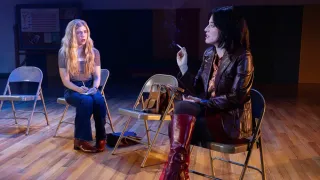March 1, 2022
Going Commando: Juba Kalamka on his New Music Project
Gregg Shapiro READ TIME: 13 MIN.
Long before Lil Nas X, Tyler the Creator, or Frank Ocean made waves as queer artists in hip hop (on major labels, no less), there was an entire movement of underground LGBTQ hip hop acts doing their part to pave the way in the genre.
Among those performers was Deep Dickollective, co-founded in early 2000 by queer Black activist and artist Juba Kalamka. Since that time, Kalamka has remained active in music in a vast array of musical outfits, as well as appearing in movies, and remaining active politically and socially.
Bay Area-based Kalamka's latest musical outing Commando is the kind of band that earns the right to be called a supergroup, and a queer one at that. Featuring Kalamka, Lynnee Breedlove (of Tribe 8 fame) and Honey Mahogany (of RuPaul's Drag Race renown) among others, Commando commands our attention with its rap-metal approach and thought-provoking lyrics. Juba was kind enough to answer a few questions in advance of the March 2022 release of Commando's debut album on Kill Rock Stars.
Gregg Shapiro: Juba, in preparing for this interview, I went back and listened to Deep Dickollective's second album, "The Famous Outlaw League of Proto-Negroes," which was the first time I'd been exposed to your work. Considering the way that hip hop, and queer hip hop, in particular, has evolved over time, where do you see DDC's contributions to the genre in the scheme of things?
Juba Kalamka: I think Deep Dickollective, for better or worse, served as a legitimizing force for some people, though that's not something I'm always comfortable with. From the beginnings of the group, we were steeped in the parodic – picking at our postgrad smartass educational contexts taking a lot of inspiration from the early 1990s Black gay performance troupe Pomo Afro Homos (the inspiration in part for the title of our album "BourgieBohoPostPomoAfroHomo").
There were serious elements to what we did, but we felt from the jump that self-seriousness would get in the way of what we were trying to do, which was bringing an "edutainment" element, or as elder Black folks would say – "fackin' and crackin'" – was central to the project.
At the same, time there were ways that people were very interested and invested in what we were doing that were diametric to what we were trying to put across – and were steeped in homonormativity and respectability politicking relative to Black queer experience.
Regardless of what we said in our lyrics, it became clear that many folks (white and non-white) dug that we were (except for one member) cisgender, postgrad-educated, and connected to elite institutions, hegemonically pretty, invisibly disabled, and coded as authentically "Black" and Africentrist (dreadlocks, mostly dark-skinned and masc) in ways that didn't directly challenge femmephobia in Black gay men's community and racist/white supremacist narratives around the alternating fetishization and loathing of Black bodies in mainstream white gay culture.
I think the people who supported us really appreciated and enjoyed us and were enthusiastic about it. It did become apparent over the life of the project that there wasn't any one cohort or scene that was completely comfortable with us for the aforementioned reasons, which, ultimately, I think is okay [laughs].
Of all the music genres to make a comeback in 2022, I never expected it to be "the perverse and anachronistic lens of nü metal," as the music of Commando is described. Why was this style of music the right fit for your new musical act?
I think back to a conversation I had in 2002 with writer Michelle Tea about the queer hip hop scene that had been germinating online in the late 1990s and that came to life at the PeaceOUT Festivals and other shows around the U.S. To paraphrase, she said that what was cool about "homohop" as a notion was that it stretched the space of what was possible.
Hip hop and rap in the main is still pop music, so it very much adheres to the same retrograde cis-hetero-patriarchal narratives and tropes that rock, jazz, country, classical, and other genres do around racialization, gender, ability, class, sexuality, and the like.
The melange of styles present in rap-rock and nü metal make it perfect for a variety of storytelling approaches lyrically, sonically, and emotionally. It's been a good challenge for all of us to figure out how we want to expand our very different individual conversations on the same core of topics, and form that into a coherent narrative.
Andy Meyerson (drummer/percussionist/artistic director of The Living Earth Show/TLES and Commando's co-founder) was an eleven-year-old gay kid in the late 1990s and listening to rap-rock on the radio and troubled by the lyricism and public behavior of the bands in that scene (think the debacle that was Woodstock 1999) but was rapt by the performative energy and propulsiveness of the rhythm sections and was inspired to become a drummer.
By that time, I was in the middle of a four-year hiatus from music-making before moving to the Bay Area in 1999 and was listening to acts in the genre here and there, but having issues with the music similar to those I had that informed my exit from the hip hop scenes I performed in around Chicago in the late 1980s-mid 1990s, and I certainly wasn't interested in navigating homophobia, misogyny, and racist bullshit as a performer or consumer.
Once I had a closer listen to some of the bands that were popular in the period I saw that the performances lent themselves to some of the same aforementioned deconstructionist parodics that I'd engaged with Deep Dickollective. By the time I met Andy and Travis (Andrews, guitarist of TLES) in 2017, DDC had been defunct for nine years.
In the meantime, I'd done a ton of performance art, appearing in queer porn features, and had produced several albums of electronic music and was producing other artists as well. Commando represented a new musical challenge and an opportunity to have some fun at the same time.
How did Commando, which boasts an amazing line-up of talent, including Lynnee Breedlove of Tribe 8 fame and Honey Mahogany, come to be?
Part of what was appealing for me when I came into Commando was that it already existed, had done shows, and had an identity already as a collectivized project. Though DDC was largely a creative collaborative process, the business of it – promotion, booking, recording, etc. – was organized and driven by myself through the sugartruck recordings imprint. The end product was great, but the process was an exhausting constancy of cat-herding, I wasn't interested in doing that again.
Lynnee contacted me in early 2017 about meeting these two people he was working with on this band project. I've known Lynnee since 2001, and he's been an amazing friend, colleague, and community advocate. We toured together in the early 2000s and worked on a variety of other projects.
He convinced me to meet Andy and Travis at a cafe near my job. I talked to them for maybe 30 minutes, in which I expressed my reservations and they responded with all the right things. They were grown-ups in the way I needed collaborators to be at the moment.
Andy is really well-connected across a variety of musical and cultural communities, and it was largely through him and Lynnee that I have a context for other current members of the group. I knew of Honey from "Drag Race" and met her through her work in transgender health advocacy but learned about her music later.
The same would go for Drew Arriola Sands (lead singer of Trap Girl, founder/curator of TransgressFest) and Krylon Superstar – I knew of their group Double Duchess, but didn't make the association until meeting them.
The song "Meatswinga (Morello Muh Mello)," features a reference to Rage Against the Machine's Tom Morello in the title. RATM is a band whose influence can be felt sonically on the album.
Travis, Andy, and I were talking during a practice session about RATM and their approaches to songwriting and composition. Somewhere in there, I was talking about my main employ (Community Healthcare Director at St. James Infirmary) and my experiences as a sex worker.
Andy mentions a story he read about Morello having worked as a party stripper during college at Harvard, calling himself "Meat Swinga." I didn't believe it at first, but it was true. So I said, "I'm gonna write a song about that." It turned about as a song about me, with a mix of both true-to-life and popular cultural references to sex work.
We contacted Morello's people about the song and sent it to them, but I don't know if he's heard it or is aware of it. I think he'd dig it [laughs].
The first single, "Hotel Essex," pays homage to the late gay poet and activist Essex Hemphill, and the video features gay musician and activist Blackberri, whom we lost in late 2021. What do these two icons mean to you?
I saw Marlon Riggs' 1989 videowork "Tongues Untied" for the first time at age 19 (on the PBS series P.O.V.) in early 1990.
I knew I was bisexual at 15, but didn't come out until 1995 at 25. "Tongues" was my first context for Hemphill's work, as I didn't get a hold of the "Brother to Brother" anthology until 1992. He and artist Wayson Jones perform the poem "Now We Think" as a percussive, multi-tracked "indigenization" of the phrase "now we think/as we fuck" as "nawathinkawafuh," with grunts and glottal stops between the poem's phrases.
I was blown away by it! It was hip hop, it was spoken word, it was the rhythm of my natal Africentrist/Cultural Nationalist community in Chicago, a place that I came to understand as stridently conservative despite its "progressive" protestations and ministrations, and though I'd grown up with a lot of euphemistic homophobia grounded in family values-style rhetoric, I hadn't experienced pointed and vociferous antagonism from that space until the release of "Tongues."
I remember seeing Blackberri (who was 46 when "Tongues" was shot) and being shook! This big, tall, graying Black man with bicep-length dreadlocks – I had just started my dreads. He looked like one of my teachers. He looked like me. I pushed that down some more inside, which was hard because I was reading Windy City Times a lot and hearing about the poets and performers who'd been in the movie dying, and later Marlon and Essex.
I'd been in the Bay Area for about a month in early 1999, had been fired from a job, and was a day away from my first night sleeping outside (and a month in a Richmond shelter) when I ran into Blackberri while he was doing outreach. I had a complete fanboy freakout that he was really nice about.
We eventually became friends and colleagues and were neighbors for 16 years. He was a generous mentor to me, and shared at length over the years a zillion backstories and adventures he'd had as a musician and activist in the Bay Area and beyond.
We'd worked on a variety of performance projects together and were planning to record. I approached him about being in the video for "Hotel Essex" in August of 2021, and he was down after I described it as a "Marcus Garvey-themed circuit party." The scene in which he appears is an homage to the doo-wop scene, "Hey Boy Come Out Tonight," where he is a co-lead vocalist. I think Hotel Essex was the last project he worked on in film, as he was hospitalized about a week after shooting.
"Comin' For Ya" directly addresses the terrifying rise of white supremacy during the presidency of Biden's predecessor. Additionally, the song makes reference to the threat going all the way to march that took place in Skokie, Illinois (as an aside, where I grew up) in the 1970s. Would it be fair to say that the song is as much a call to action ("Is it okay to punch Nazis?") as it is a history lesson?
Yes! I was particularly excited about doing a verse on the song for both of those reasons. I grew up on the west side of Chicago (North Lawndale, Austin) right after the rebellions that followed the assassination of Dr. Martin Luther King, Jr.
I attended an independent Africentrist school and one of my field trips in 1975 was to the trial hearings in the murder of Chicago Black Panther Party chair Fred Hampton. My dad is a retired history teacher and my mom was active in the Black theater scene of the time, so they were really big on knowing the history.
I remember hearing about the National Socialist Party (NSPA) marching in Skokie. I remember the night in November 1974 when we had a brick thrown through our living room window, and my verse was inspired by an incident in the summer of 1975 where my mom, my aunt, and my cousin fought a group of men attacking my cousin's new house in the Marquette Park neighborhood (where the NSPA was headquartered, after a laughing non-response from a call to the police) with an ebony wood cane, a pair of pinking shears and a bicycle sprocket, respectively. They put those fucks in the hospital.
Lynnee and I have talked a lot over the years about queer punks and themes of antifascist resistance, and how often these stories get expressed as abstractions because even when we do get the chance to talk about them it's usually someone asking for a "tell us about the bad old days" narrative that they can separate themselves from instead of bringing it into the now, where it's more likely they'd have to personally account for their associations with such. The previous president's admin didn't create these dynamics. They just magnified, emboldened, and encouraged elements and expressions that were already there.
The album closes with a quartet of tribute songs. "The Shock of Gary Fisher" (about the late gay author), as well as songs about musicians – "George Michael," "Prince," and "Mykki Blanco." What do you think of the tribute song as a musical art form?
I think when tribute songs are done well, they can give amazing windows into a subject's life, even when that's directly from the writer's specific experience and understanding of them. I've been surprised at some of the parallel notions that get spoken to in songs we wrote separately.
Lynnee was an out queer adult and 11 years older than me when he first encountered Prince's work in the early 1980s, but we were struck by his conversations on race, gender, and sexuality in very similar ways.
"The Shock of Gary Fisher" is based on an essay of the same name by Dr. Robert Reid-Pharr from his 2001 collection "Black Gay Man," and it represented an opportunity to talk about work that was created on a similar timeline to that of Essex Hemphill's and was as powerful from different angles but wasn't quite as known as it wasn't published until after his death.
With that in mind, it was important that "Mykki Blanco" was the closing song. In addition to being an inspiration to our work, they are an alive, vibrant, and active storyteller and performer themselves. The memorial and historical aspects of the album are important, but the inclusion of stories about living, moving, breathing, and thriving people were crucial to the "superhero" thread of the project. We here, we Black, we Brown, we queer, you may or may not get used to it, but that's what's going to be.
Help keep the Bay Area Reporter going in these tough times. To support local, independent, LGBTQ journalism, consider becoming a BAR member.






